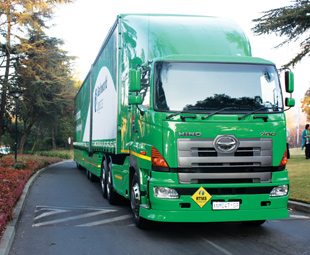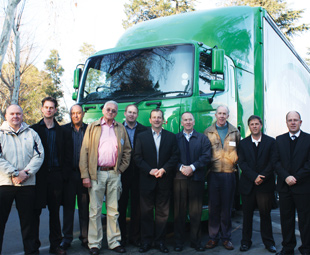Seeing green

Barloworld Logistics is streaks ahead of the pack with its new Green Trailer. CAITLYN MOONY takes a look at the aerodynamically designed truck-trailer that drastically lowers fuel consumption.
For night-owls, it is seldom that we drag ourselves out of our homes by 6.30 am and are particularly impressed by anything at all. I was surprised, therefore, to find myself at the early-morning launch of Barloworld Logistics’ new “Green Trailer” with the thought crossing my mind, “Now there’s a good-looking trailer combination right there.”
But although it is undeniably eye-catching (it is green in colour), its appearance is not the most notable feature. Most importantly it is environmentally green, due to the structural changes that have made this interlink taut liner trailer different from any other on the South African market.
The main “green” advantage of this truck-trailer is its drastically lowered fuel consumption. With the sustainability of the earth’s primary energy sources an increasing concern, Barloworld Logistics has done well to acknowledge that the commercial transport industry is one of the most taxing on these resources. As Francois van Rensburg, divisional director of Barloworld Logistics, points out, “Transport is the biggest area in logistics that affects the environment directly, but is one of the easiest components to address strategically.”
According to a Council for Scientific and Industrial Research (CSIR) study, 13% of the country’s total greenhouse gas emissions can be chalked up to transport. Barloworld Logistics decided to work with the CSIR as well as Hino (who supplied the truck), Afrit (who made the structural changes) and Aero Truck (who was responsible for the manufacturing of the aerodynamic components) to create the aerodynamic Green Trailer.
The truck tractor Hino supplied for this project is a Toyota Hino 57-450 6×4 with air suspension. The trailer combination is an Afrit Super link Tautliner, with a carrying capacity of 36 t. Although the trailer combination is usually fitted with dual tyres on each axle, this particular trailer is fitted with super single tyres. This was done in order to ensure that width restrictions would still be met once the aerodynamic additions had been made.
It was important for Barloworld Logistics to make the changes while staying within the legal limits of the truck’s specifications. “The focus of the project was to provide a sustainable road transportation solution for our clients that is both practical and which complies with legislation,” says Van Rensburg.
 Another important factor for Barloworld was receiving Road Traffic Management System (RTMS) accreditation. The RTMS is an initiative aimed at encouraging operators in the logistics industry to adopt practices that improve road safety and productivity, but also preserve road infrastructure. RTMS accreditation is important to Barloworld Logistics in that it shows they are operating both responsibly and productively. The Green Trailer project means that Barloworld Logistics is the first general freight operator in the country to receive RTMS accreditation.
Another important factor for Barloworld was receiving Road Traffic Management System (RTMS) accreditation. The RTMS is an initiative aimed at encouraging operators in the logistics industry to adopt practices that improve road safety and productivity, but also preserve road infrastructure. RTMS accreditation is important to Barloworld Logistics in that it shows they are operating both responsibly and productively. The Green Trailer project means that Barloworld Logistics is the first general freight operator in the country to receive RTMS accreditation.
South African research on the green trailer, conducted mainly on the N3 between Johannesburg and Durban, corroborated initial research done in the UK showing a curtainsider teardrop rigid travelling at a constant speed of 80 km/h could lower fuel consumption by 20.4%. The same research showed that a curtainsider semi-trailer travelling at a constant speed of
63 km/h could achieve a saving of 10.1%. Speaking of the ongoing South African research Van Rensburg claims proudly that, “With these changes, a massive 35% reduction in total drag could be achieved when travelling between 70 and 80 km/h, and six to eight percent reduction in fuel consumption is expected for the next six months.”
Van Rensburg also claims that the trailer will be safer than others in that in rainy weather the aerodynamic changes will prevent excessive tyre spray, which affects the vision of other road users. The aerodynamic truck is also more stable, as it is not affected as badly by windy conditions.
Dr Rene Heise, aeronautical engineer for the CSIR, explains that the changes could be made effectively to this truck-trailer because it operates mainly on long distance roads. In rougher terrain – such as that experienced by timber and mining trucks – the aerodynamic components may get damaged. Some of the changes Heise was responsible for designing were the fairing onto the bottom front end of the truck and the fairings alongside the truck and trailer. These lower wind resistance and decrease air access to the axles. “It was important to keep the sides as clean and smooth as possible – minimising the gap between truck and trailer,” says Heise. In order to minimise the effects of the low pressure cell created at the back of the truck, a section of the top was dropped. “Although it would also have been beneficial to curve the back of the truck for aerodynamic reasons, it needed to remain flat for loading.”
Johan Hagg of Afrit stated it was very proud to be associated with the project and with Barloworld Logistics. “The manufacturing of the trailer itself did not require many changes; it was fairly standard except for ensuring it would stay within legal size limits after the aerodynamic panels had been added. Credit must go to Aero Truck for its aerodynamic changes.”
Dr Casper Kruger, vice president of Hino South Africa, says that he is very excited for Barloworld Logistics. “They are always leading the way, always innovative. What we see here today is a manifestation of what they stand for.” Kruger points out that the South African economy is very much dependent on trucks. “If there are no trucks on the road, the economy comes to a halt. So what Barloworld is doing is trying to prolong the trucking industry by making it safer, greener and even more comfortable for drivers.”
Cameron Dudley-Owen, owner of Aero Truck, is equally excited by the project. He says, “This project was just such fun to work on.” He too congratulates Barloworld Logistics on actually going through with putting this vehicle on the road. “They have the money and the clout, but most importantly they have the drive to put a project like this into action,” he notes. Unwilling to comment on exact figures spent on the project, Dudley-Owen did mention that it was a substantial investment for Barloworld Logistics and that the company did not cut any corners to spare expense.
Both Kruger and Dudley-Owen agree that Barloworld Logistics is setting a great example for other companies in the industry. “This is a fantastic achievement; hopefully it will influence the rest of the industry,” says Kruger. Dudley-Owen agrees that he would like to see the design used in other vehicles. “It’s great to see an industry leader such as Barloworld Logistics actually making changes, not just resting on their laurels. Hopefully we will now see a change in mindset of others in the industry,” he suggests.
Van Rensburg is of the same opinion, saying that companies need to start embracing more environmentally friendly technology. “Businesses that move early to develop robust commercially-focused carbon strategies will gain real competitive advantage and market share in the global economy.”
Published by
Focus on Transport
focusmagsa



